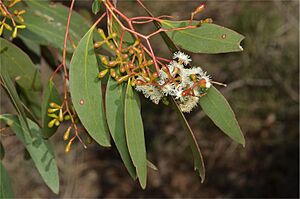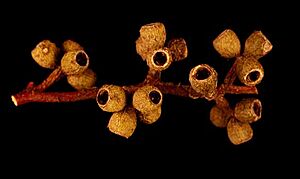Bull mallee facts for kids
Quick facts for kids Bull mallee |
|
|---|---|
 |
|
| Eucalyptus behriana near Cummins | |
| Scientific classification | |
| Genus: |
Eucalyptus
|
| Species: |
behriana
|
The Bull Mallee (Eucalyptus behriana) is a special type of tree or large shrub. It's also called the Broad-leaved Box. This plant is endemic to south-eastern Australia, which means it naturally grows only in that area. It's known for its unique bark, leaves, and flowers.
The lower part of its trunk has rough, fibrous bark. But higher up, the bark is smooth. Its adult leaves are shaped like wide spearheads. The flowers are white and grow in groups of seven. After flowering, it produces cup-shaped or barrel-shaped fruit.
Contents
What Does the Bull Mallee Look Like?
The Bull Mallee is a tree or a mallee. A mallee is a type of eucalyptus that grows many stems from a special woody base. This plant usually grows up to 12 metres (about 39 feet) tall. It has a special woody swelling at its base called a lignotuber. This lignotuber helps the plant regrow after fires.
Bark and Leaves
The bark at the bottom of the trunk is rough and fibrous. It can be dark brown or black. Higher up, the bark is smooth. It might be grey, green, or even coppery in colour.
Young plants and new shoots have different leaves. These leaves are arranged alternately along the stem. They are egg-shaped and measure about 50 to 105 millimetres (2 to 4 inches) long. They are also 25 to 65 millimetres (1 to 2.5 inches) wide. Each young leaf has a stalk called a petiole.
Adult leaves are also arranged alternately. They are broadly lance-shaped or egg-shaped. These leaves are 45 to 130 millimetres (1.8 to 5.1 inches) long. They are 13 to 50 millimetres (0.5 to 2 inches) wide. The adult leaves are glossy green on both sides. Their petioles are 10 to 22 millimetres (0.4 to 0.9 inches) long.
Flowers and Fruit
The flower buds of the Bull Mallee grow in groups of seven. They are usually found at the ends of the branches. Each group of buds sits on a stalk called a peduncle, which is 3 to 10 millimetres (0.1 to 0.4 inches) long. The individual flowers usually don't have their own stalks; they are sessile.
Mature buds are oblong to oval in shape. They are green to brownish. These buds are 3 to 7 millimetres (0.1 to 0.3 inches) long and 2 to 4 millimetres (0.08 to 0.16 inches) wide. They have a conical or rounded cap called an operculum.
The Bull Mallee mainly flowers from September to February. Its flowers are white. After the flowers, a woody fruit develops. This fruit is a capsule, which is a dry fruit that opens to release seeds. It is cup-shaped or barrel-shaped. The fruit is 3 to 6 millimetres (0.1 to 0.2 inches) long and 3 to 5 millimetres (0.1 to 0.2 inches) in diameter.
How Was the Bull Mallee Named?
The Bull Mallee was first officially described in 1855. This was done by Ferdinand von Mueller. He was a botanist for the Victorian Government. His description was published in a scientific paper.
The plant's scientific name, behriana, honours a person named Hans Hermann Behr.
Where Does the Bull Mallee Grow?
The Bull Mallee has a disjunct distribution in south-eastern Australia. This means it grows in separate, unconnected areas.
In New South Wales, you can find it in mallee shrubland. This is near a town called West Wyalong. In Victoria, it grows in the Mallee and Wimmera regions. These are in the north-west part of the state. There is also a small group of these trees further south. This group is near Bacchus Marsh, including the Long Forest Nature Conservation Reserve. In South Australia, the Bull Mallee is found scattered across the south-east.



